
Growing up in East Tennessee, okra was one of the most common vegetables I both ate and grew. Now that I live in the Midwest, I don’t see the crop as often in community gardens and at farmers markets. Yet you may have found this summer, as I have, that okra deserves a place in the summer garden.
The plant is very much a summer staple, thriving in warm soil temperature and the summer heat we encounter. It’s also one that looks very different compared to your other summer crops. When you think about summer crops of solanaceous like tomatoes or cucurbits like zucchini, the okra plant can really stand out in the summer garden with it’s sturdy, single stalk reaching 3-5 ft tall and broad leaves of 8-12 inches in diameter. In fact, if this is your first summer with okra you may have mistaken it for a weed.
Okra is in the Malvaceous plant family. Other agricultural members include cotton and cacao though suspect you’ve probably not grown these before. The Malvaceous plant family members you’ve probably grown or are familiar with are hibiscus and hollyhock. Both of these ornamental plants are two that I commonly see in many home landscapes. While in the same plant family, hollyhock and hibiscus are in two different genera than okra.
Along with its height and growth structure, okra plants are known for their flowers. These cream-colored, hibiscus shaped flowers will be found against the plant stalk, below the large leaves. While not as big as hibiscus flowers, I have certainly attended weddings in the south where okra flowers have been used in boutonnieres. Each flower will produce a single pod once it has been pollinated. These are what you are after to harvest and cook.
While the okra plant is a single stalk, its leaves take up a far greater amount of room which then makes it that you do need to consider it’s spacing requirements. Between plants in a row, okra should be planted 9-12 inches and between rows of 3-6 feet. I have found that my spacing is probably a bit too close this season for some of my okra plants.
Summer insect pests do like okra. Japanese beetles can thrive and defoliate the okra plant depending on the growth stage of your okra plants. Anecdotally, my okra plants did not overlap too much when I had a heavy infestation of Japanese Beetles and currently have 2-3 beetles on the leaves that I am removing by hand every day. Pods may also be deformed due to the Brown Marmorated Stinkbug, which can cause your okra pods to be misshapen and twisted. You may see that as you harvest your pods.
One of the main tips that okra enthusiasts will share with new okra growers is when to harvest okra. The pods should be harvested when they are 2-3 inches in length. Bigger than this and you will find that the pods are woody and not as tender as they could be. This harvest practice goes against what we sometimes think about when it comes to growing vegetables as bigger is encouraged. Yet for okra you want small pods. The pods should be a very vibrant color, either green or purple depending on the variety you are growing. Pale pods, even if the right size, can be woody. Pods form quickly during the peak of summer and you should look to harvest every 2-3 days.
Pods should be cut using pruners from the main stalk, living a bit of a tip to the pod. You might also consider wearing gloves and long sleeves as the okra leaves and pods have very fine hairs that may cause some irritation to your skin. One of my main memories of my grandmother is “suiting up” to harvest from the long rows of okra that we would grow.
Pods should not be washed immediately unless you plan to cook with them that day. If pods stay wet, they will potentially begin to mold and develop a slimy, outer coating. You are better off washing the pods closer to when you decide to cook with them.
Once you have your pods and decided on your recipe, consider how you cut the pods. Mucilage is the “slime”/”goo” that is released as soon as you cut into a pod and smaller pieces can produce more mucilage in your cooking compared to bigger pieces. This is one of the reasons many do not like to eat okra. Work with speed and make bigger cuts so as to reduce this mucilage if that’s what you are after.
By harvesting at the right size, it will ensure you're able to enjoy your okra this season- and it finds a place in future summer gardens to come.